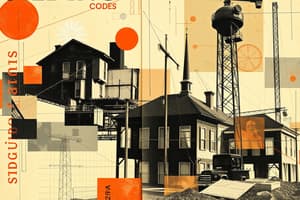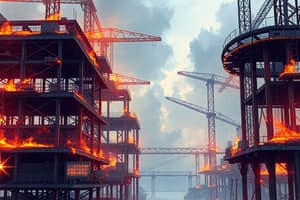Podcast
Questions and Answers
Which type of construction is composed of materials that will not contribute to fire development or spread?
Which type of construction is composed of materials that will not contribute to fire development or spread?
- Type I
- Type V
- Type II (correct)
- Type III
In Type II construction, what is a characteristic of the steel components compared to Type I?
In Type II construction, what is a characteristic of the steel components compared to Type I?
- They are more prone to collapse
- They are heavier
- They require additional fire protection
- They have a lower fire-resistance rating (correct)
Which type of construction is commonly found in mercantile, business, and residential structures?
Which type of construction is commonly found in mercantile, business, and residential structures?
- Type III (correct)
- Type V
- Type IV
- Type I
What material are the exterior walls and structural members constructed of in Type III construction?
What material are the exterior walls and structural members constructed of in Type III construction?
Type IV (Heavy Timber) construction is characterized by the use of what kind of materials?
Type IV (Heavy Timber) construction is characterized by the use of what kind of materials?
What characteristic helps prevent unseen fire travel in Type IV construction?
What characteristic helps prevent unseen fire travel in Type IV construction?
What construction type provides the highest level of protection from fire spread and structural collapse?
What construction type provides the highest level of protection from fire spread and structural collapse?
Which materials are commonly used in Type I construction?
Which materials are commonly used in Type I construction?
Why are Type I structures often incorrectly referred to as fireproof?
Why are Type I structures often incorrectly referred to as fireproof?
What role can combustible materials like furniture play in a Type I structure during a fire?
What role can combustible materials like furniture play in a Type I structure during a fire?
Why may roofs in Type I structures be difficult to penetrate during a fire?
Why may roofs in Type I structures be difficult to penetrate during a fire?
What is the main reason for compartments in Type I structures retaining heat during a fire?
What is the main reason for compartments in Type I structures retaining heat during a fire?
Which of the following materials is considered noncombustible?
Which of the following materials is considered noncombustible?
What type of construction includes framing materials that consist of wood 2 x 4 or 2 x 6-inch studs?
What type of construction includes framing materials that consist of wood 2 x 4 or 2 x 6-inch studs?
How is stucco applied in Type V construction?
How is stucco applied in Type V construction?
What is a characteristic of vinyl siding in Type V construction?
What is a characteristic of vinyl siding in Type V construction?
In Type V construction, what is the purpose of exterior insulation?
In Type V construction, what is the purpose of exterior insulation?
What is a distinguishing feature of prefabricated wood truss systems in Type V construction?
What is a distinguishing feature of prefabricated wood truss systems in Type V construction?
What happens under fire conditions to plywood I-beams used in Type V construction?
What happens under fire conditions to plywood I-beams used in Type V construction?
Which materials are more frequently used in modern Type V construction for connecting engineered structural members?
Which materials are more frequently used in modern Type V construction for connecting engineered structural members?
Flashcards are hidden until you start studying




